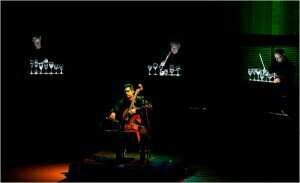
George Crumb
Written as a response to the ongoing war in Vietnam and Southeast Asia, he takes the classical quartet and expands it through the use of percussion, vocalizations by the players, and extended instrumental techniques for the string players. At times, the string players apply their bows to musical glasses, providing a unique, other-worldly ephemeral sound.

Kronos Quartet: Jeffrey Zeigler, cello, and, David Harrington, Hank Dutt and John Sherba bowing goblets (2008).
© David Goldman
Crumb: Black Angels: 13 Images from the Dark Lang, “Images I”: No. 1. Departure (Kronos Quartet)
Part I: Departure:
I. Threnody I: Night of the Electric Insects
II. Sounds of Bones and Flutes
III. Lost Bells
IV. Devil-music
V. Danse macabre
No. 2. Absence
Part II: Absence:
VI. Pavana Lachrymae
VII. Threnody II: Black Angels!
VIII. Sarabanda de la Muerte Oscura
IX. Lost Bells
No. 3. Return
Part III: Return:
X. God-music
XI. Ancient Voices
XII: Ancient Voices
XIII. Threnody III: Night of the Electric Insects
You might see in some of the titles echoes of other works – the dance macabre appears in a number of 19th century works and the Pavana Lachrymae section contains quotations of Schubert’s Death and the Maiden Quartet, yet it should be played ‘Grave, solemn, like a concert of viols,’ as Crumb wrote in the score, returning is to the weeping songs of Dowland. You’ll even hear a bit of the Dies Irae in the high string harmonics.
It’s a very deep and evocative work that uses the dissonance and the extended techniques to great advantage in setting the feeling he wants.

Ge Gan-Ru
© Zelin Wang
Ge: String Quartet No. 5, “Fall of Baghdad”: I. Abyss: Screaming – Living Hell – Barbaric March – Abyss – Threnody (ModernWorks)
The pain and agony of the first part are relieved by the second part: “Music From Heaven.” In a moment of respite, our soldier can observe the world around him.
II. Music From Heaven: Pilgrimage – Bazaar – Caliph’s Drum – Music from Heaven
Just as Crumb used the songs of mourning, threnodies, as his markers, so Ge uses them as well. A threnody ends the first part, and the actions of the final three sections part, ‘Weeping – Moaning – Keening,’ are those of a threnody as well.
III. Desolation: Desolation – Weeping – Moaning – Keening
The work ends in utter despair, as though the composer has given up on the entire idea of peace in our, or anyone’s time.
